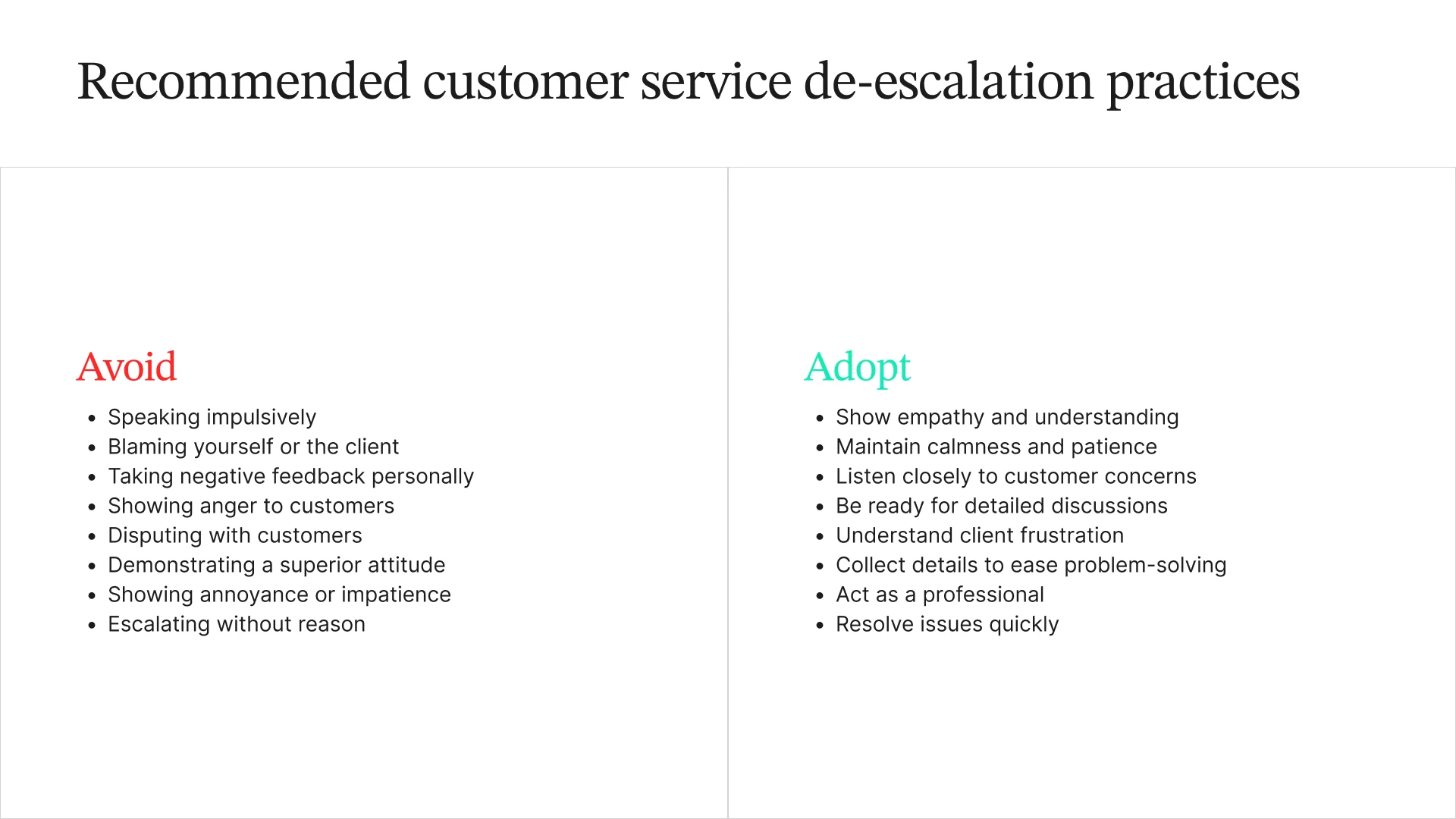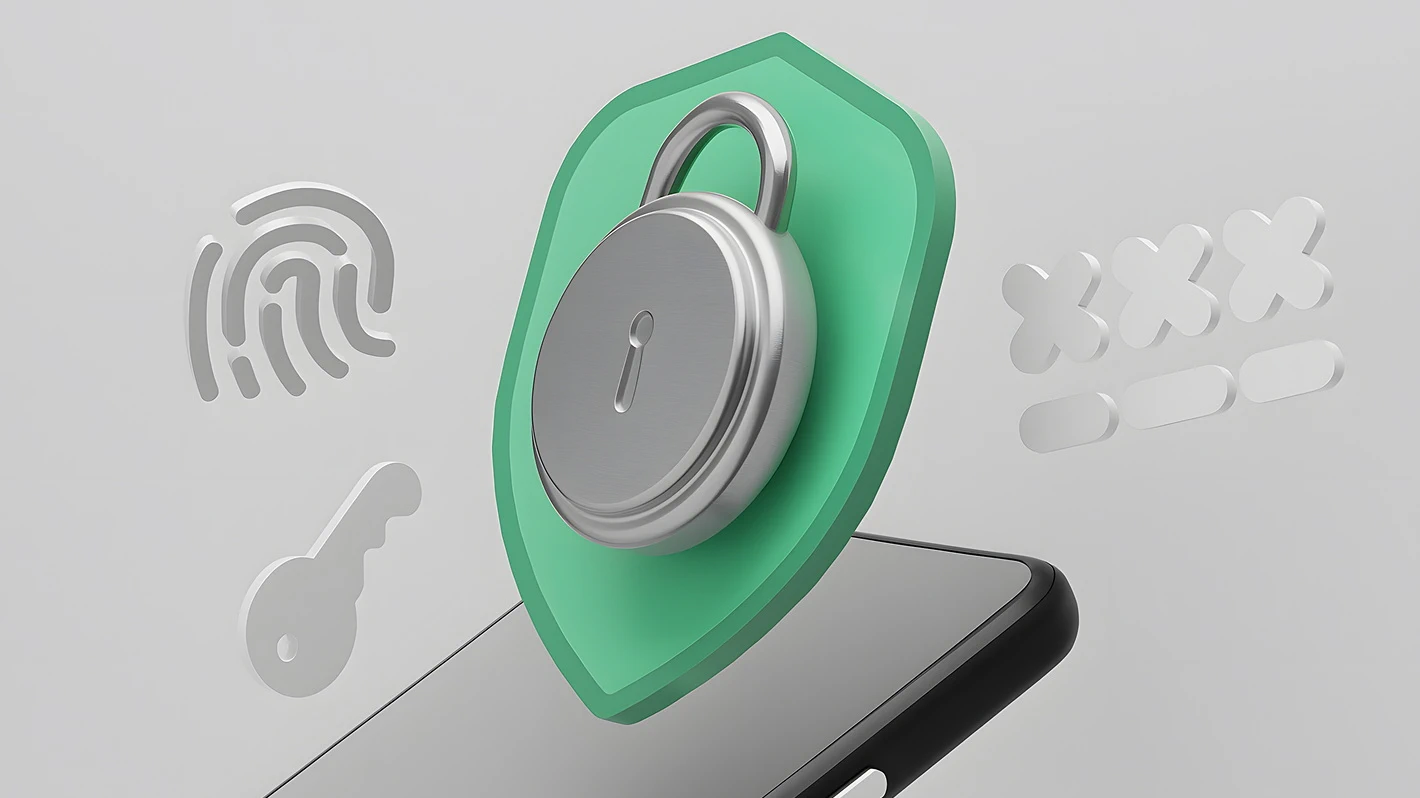Mastering how to de-escalate an angry customer is an essential skill for anyone in CS service. There are many reasons why clients might be upset. It could be just a bad day, their natural way of acting, or something specific that’s bothering them about your service or product. A good customer service agent doesn’t just communicate and answer questions, they try to figure out why the client is unhappy and help fix the problem to make them feel happier.
Based on recent statistical data, 35% of customers have experienced feelings of anger or frustration during their interactions with customer service representatives. This shows the importance of effective communication and the potential need for improved training in handling such situations.
Angry customer interactions can be truly challenging, but using de-escalation techniques for customer service can lead to productive and respectful conversations. By focusing on solution-driven dialogues, you can improve customer satisfaction. Interested in implementing these methods? See how to handle tense situations through different channels.
Why De-escalation Techniques are Crucial in Customer Service
Customers who are angry or frustrated often start using harsh words and unfair treatment towards customer service agents and may leave negative reviews about the company. Successfully implementing de-escalation techniques for customer service is essential in managing these situations. This can mean the difference between retaining a loyal and satisfied customer or dealing with an unhappy user.
De-escalation techniques are strategies used in diverse fields, especially customer service, to mitigate conflicts. These methods often require professionals to manage their emotions, helping them effectively support distressed individuals and achieve their work goals.
There are two common scenarios that particularly frustrate customers: First when they have to repeat the same information to different agents and cannot connect with the one they initially communicated with, which annoys 33% of users. Second, waiting too long on hold also upsets 33% of users.
Simply providing accurate information and prompt responses isn’t sufficient. It’s necessary to deliver this information in a manner that is calming and empathetic, ensuring the client feels both understood and valued. Ultimately, the effectiveness of your customer support team hinges on their client service skills.
5 Types of Angry Customers and De-escalating Methods
Regardless of the exceptional service you offer, it’s essential to recognize that not every client will always be satisfied. Some may have elevated expectations, while others might just be having a challenging day. As we explore the five common types of challenging or discontented customers, we’ll also discuss how to de-escalate the situation with each type.

The Aggressive Customers
Typically these people are quick to anger, critical, and often verbally abusive, believing their needs are paramount. They may shout, complain, or even become physically confrontational.
Handling Approach:
Based on the techniques from customer service de-escalation training, it’s important to remember that regardless of who’s right, it’s best to apologize calmly and confidently. Ask them to specify their issue after they’ve calmed down. Avoid matching their aggression, respond politely, and don’t take their comments personally. Once they’re composed, offer a solution. If you work with them properly, such customers can become loyal advocates for your business.
The Habitual Complainer
Some clients, termed habitual complainers, find faults in nearly everything — from prices to trivial details like shirt colors. They are hard to please, often leading to exhaustion and stress.
Handling approach:
Recognize that you can’t please everyone, especially habitual complainers. Always listen attentively and focus on de-escalating any rising tensions. Respond calmly without making excuses. Address genuine concerns where possible, and aim to resolve multiple complaints in one go to minimize interactions. Creating and managing digital content that addresses common complaints can also help in reducing frustration by providing clear, accessible information.
The Indecisive Customer
These clients constantly seek assurance on aspects like price and quality. They often pose many questions but struggle to finalize a purchase.
Handling approach:
Before dealing with angry customers like this type, determine their main concern, be it price or quality. Use incentives or limited-time offers to prompt a decision. Employ persuasive communication and remain calm but firm to save time and drive sales.
The Impatient Customer
People like this demand immediate solutions and may not understand constraints, whether it’s unavailable features or after-hours limitations. Their impatience often manifests as frustration, using phrases like “I can’t believe it” or threats to choose competitors.
Handling approach:
Ensure a swift response. Use de-escalation techniques when addressing concerns to maintain a calm environment. Explain any delays and reassure them of your commitment to assist promptly. If possible, redirect them to available colleagues for quicker service.
The Know-it-all Customer
‘Know-it-all’ clients believe they are experts, often dominating conversations and being critical. Their demeanor may be a tactic to negotiate a better deal.
Handling approach:
Boost their ego with genuine compliments about their product knowledge. Avoid confrontations. If correcting them, start with agreement, e.g., ‘You’re right, but…’. Ensuring they feel heard and valued can lead to loyalty.
9 Best Customer De-escalation Techniques
Managing interactions with upset users is a challenge that every business occasionally faces. Mastering de-escalation techniques for customer service is essential to turn these potentially negative encounters into opportunities for growth and trust-building.
Many angry customers choose to call directly, feeling that phone conversations are more immediate and personal than chat, email, or social media. This trend is supported by data, with roughly 40% of user complaints coming in over the phone. This is where proper communication techniques are crucial. Effective de-escalation not only calms the present situation but also promotes lasting customer loyalty. In this guide, we’ll explore the best methods to soothe and satisfy an angry customer.
Technique #1: Become an Attentive Listener Who Does Not Interrupt
When a customer is upset, it’s crucial to give them your full attention. Don’t interrupt them, rush, or just think about what you’re going to say next. When people feel you’re really hearing them, they start to calm down.
Ask clients questions and really hear the answers. This not only helps you understand their problem more deeply but also allows you to see where they’re coming from. Remember, there’s your side, their side, and then there’s the truth. Be open to seeing things from their point of view. Good listening often involves asking the right questions and letting the client share their feelings and needs without interruption.
Pro tip: After listening to the customer’s story, you can use certain phrases to help them shift away from strong emotions. For example, you could say, “I’m sorry you feel this way,” or “Thanks for letting me know about this.”
Don’t make hasty conclusions or assume you know what the customer is feeling or trying to say.
Technique #2: Show that You Care and Understand the Customer
It’s crucial to not just understand the complaint but to really listen to the person. Show your empathy and even support in some cases. Let them know you’re on their side and that their concerns will be addressed. When customers feel truly understood, they’re more likely to share their problems calmly. This approach is key in learning how to handle difficult customers.
By putting yourself in their position, you can better help calm the situation. When they see you’re really trying to help, they’re more likely to work with you to find a solution.
Did you know that a survey showed about half of the customers prefer interacting with empathetic agents? It seems that showing empathy is one of the best ways for CS reps to calm the customer and smooth tense situations.
Pro tip: Here are a few de-escalation phrases to show empathy when clients face challenges.
“I understand how frustrating this must be for you.” This remark directly recognizes the customer’s distress. Another way to convey understanding could be: “I’m committed to resolving this issue just as much as you are.”
Don’t dismiss or belittle their feelings when interacting with the customer.
Technique #3: Shift from “No” to “How Can We Help?” Strategy
When a customer is angry, it’s even more crucial to be proactive in your response. Instead of just saying “no,” demonstrate that you’re committed to addressing the issue at hand. Direct rejections or phrases like “No,” “I’m not sure,” or “I can’t” might worsen the situation and we need to de-escalate it. Shift the focus to finding solutions. Use phrases like “I’ll see what I can do,” “I’m checking into this,” or “I’m actively seeking a solution.” Explain the actions you’re taking, whether that’s directing their issue to the right team or promising a timely response. Let them know you’re committed, and, when appropriate, offer interim solutions like freezing payments until the issue is sorted.
Pro tip: If there is no other way, and you still have to say “no” to a customer, it should be done respectfully and with empathy. Acknowledge their request and explain its limitations. For example, you can say, “I’m sorry for the inconvenience,” or “While this isn’t the answer you hoped for, we might have other options.”
Don’t give vague answers or promises that you can’t follow through on.
Technique #4: Keep Your Cool, Even with Nervous Customers
It’s challenging to stay calm when faced with an irate customer, especially when harsh language is involved. However, reacting emotionally can worsen the situation. It’s important to use customer service de-escalation methods to keep things from getting out of control.
Starting with deep, controlled breathing can be a valuable tool. When we are confronted, our body often goes into a ‘fight or flight’ response, causing increased heart rates and stress. Breathing deeply calms the nervous system, helping you respond rationally and reducing your stress. This brief pause also provides a moment to gather your thoughts, ensuring your reaction is constructive.
Pro tip: If a customer’s tone becomes inappropriate, it’s essential to set clear boundaries to maintain a productive dialogue. You might say: “I’d like to help, but I can’t continue with this language,” or
“I’m here to assist, but the language makes it difficult.”
Don’t engage in a shouting match or trade insults with your client. It is unprofessional and ineffective.
Technique # 5: Do Not Take Their Frustration to Heart
When interacting with an upset user, always remember it’s not a reflection of you personally. They’re reacting to the situation or a specific issue.
Pro tip: Even if they’re shouting, it’s essential to know it’s about their own frustrations and not a direct critique of you. Learning how to handle an irate customer often starts with not taking their anger personally.
Don’t let their emotions shift your focus from finding a solution, or even worse, make you doubt your own abilities.
Technique # 6 Offer Clear Solutions
During customer service de-escalation training, agents learn the importance of providing clear steps to solve their problems. Confirming you comprehend their issue builds trust. Provide immediate solutions if possible. If it demands a specialist or supervisor’s attention, clarify the next steps within 24-48 hours.
Pro tip: Keeping the client updated, especially during longer resolutions, is pivotal. You might phrase it as, “I will do everything I can to help you, though it might take [mins/hours] of time to resolve”
Don’t make assumptions or allow miscommunications, as they can worsen situations with angry customers.
Technique # 7 Show Appreciation After Resolving Issues
Knowing how to deal with upset customers is essential, and expressing appreciation is a part of that. Although only 16% of people view it as a primary de-escalation tactic, showing gratitude after addressing their concern is a meaningful gesture. It’s crucial to get the timing right, offering thanks before resolving their issue might seem insincere, increasing their frustration. However, once you’ve found a solution, emphasizing your gratitude for their patience and loyalty can enhance the overall interaction.
Pro tip: Some ways to convey this include: “Thank you for your patience while we work together to find a solution” or “We appreciate your understanding and loyalty.”
Don’t overdo the gratitude in every sentence, as it can come off as insincere.
Technique # 8 Minimize Hold Times for Customers
Customers can get more angry if they’re left waiting on hold. It’s best to keep the conversation flowing without interruptions. If a hold is necessary, let them know why and assure them it’ll be brief.
Pro tip: Avoiding long holds keeps the personal touch in the conversation and sets a friendly tone for the entire chat.
Don’t put the customer on hold without a reason. If you need time to find an answer, tell them it’ll just take a minute or two. Customer service de-escalation training will help avoid this problem.
Technique # 9 Check for Additional Concerns
One of the best ways to resolve issues and practice de-escalation is to try to solve everything in one interaction. After addressing the main issue, it’s a good idea to ask if there’s anything else the customer needs assistance with. So, instead of ending the angry customer call or chat quickly, ask, “Is there anything else I can help you with?”
Pro tip: Before ending the conversation, remind customers about the ways they can reach out for support in the future, and let them know you were glad to help.
Don’t rush to say “goodbye”. Instead, ask if there are any other issues to prevent one more frustrating call in the future.

Helpware’s Approach: Turning Customer Pain Points into Praises
At Helpware, we firmly believe that there aren’t truly angry customers, but rather situations that haven’t been made clear. By using the right de-escalation techniques for customer service and cultivating understanding, most tensions can be resolved, and relationships – strengthened. Let our expertise guide you in managing these situations with real support and professionalism. We know that growing a business comes with many challenges like demanding customers with specific needs, preferences and constant desire to be heard.
De-escalation techniques are just one of the many skills our customer service agents master. Through specialized training sessions and workshops, they constantly refresh their knowledge and use AI and automation for greater efficiency. Moreover, we prioritize the well-being of our team members, understanding that a customer service team directly enhances the customer experience. When they’re satisfied, so are our customers.
If you think you might be putting too many customers on hold, consider our live CS service to ensure prompt and professional communication. Interested in learning more about our customer support services and the channels we offer?











